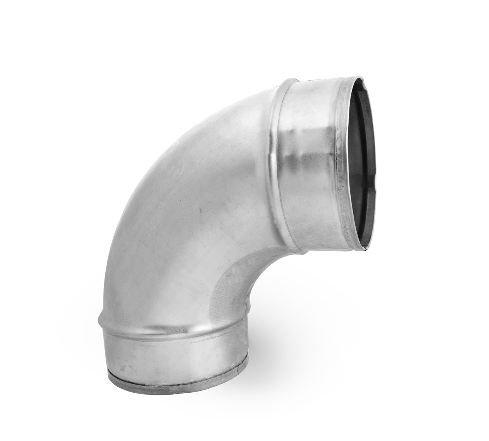
Circular elbows are components used in ductwork systems, particularly those that utilize round or spiral ducts. Here’s a detailed explanation:
What are Circular Elbows?
Circular elbows are fittings designed to change the direction of airflow in a round ductwork system. They are typically made from the same materials as the ducts they connect to, such as galvanized steel, aluminum, stainless steel, or PVC. These elbows come in various angles, with the most common being 45 degrees and 90 degrees, but custom angles can also be manufactured.
- Construction and Design
Materials: Like the ducts they connect to, circular elbows are often made from galvanized steel ranging from 0.5mm-1.2mm DX51 Z140. Aluminum and stainless steel are used in specialized environments, and PVC is used in particular settings where metal is not suitable - Angles: Standard angles include 15, 30, 45, 60 & 90 degrees. However, other angles can be created to meet specific design requirements
- Radius: Standard low velocity HVAC ductwork use half radius elbows within their design. Circular elbows can have different bend radii affecting how sharply or gradually the air changes direction. Short-radius elbows create a sharp turn, while long-radius elbows provide a gentler curve, which can reduce airflow resistance and noise.
Uses of Circular Elbows in Ductwork
Circular elbows are used for the following purposes in ductwork systems:
- Direction Change: The primary function of circular elbows is to change the direction of airflow in a duct system. This is essential in routing ducts through buildings where straight runs are not always possible
- System Flexibility: As standard elbows are available off the shelf they are ideal for overcoming obstacles which may be in your way during an installation
- Air Distribution: In HVAC systems, proper air distribution is critical for comfort and efficiency. Circular elbows help direct air efficiently down the ductwork system, ensuring that all areas are adequately heated or cooled.
Installation
- Cutting: Ensure the spiral duct sections are to the appropriate lengths to fit the elbow and the desired path
- Connecting: Elbows are a “male” component and slip inside the spiral ductwork sections (known as slip joints). These are elbows are then fixed in place by rivets or self drilling tek screws. Once fixed the joint should be sealed with ducwork sealant. For larger circular ductwork systems mating flanges for ease of installation
- Sealing: Joints are iddealy sealed with duct sealant or tape to prevent air leaks, ensuring the system remains energy efficient
- Supports: Proper support is required to ensure the elbow and attached ducts remain securely in place, preventing sagging or disconnection. It is generally good practice to support ductwork after a change in direction. Support types are: Suspenion Rings (Generally used for up to 315Ø), Split Rings or a wire support system which is more commonly used due to its speed of installation
Advantages
- Reduced Air Resistance: Round shapes and gradual bends (in long-radius elbows) minimize turbulence, reducing pressure drops and maintaining efficient airflow.
- Versatility: They can be used in a variety of HVAC and ventilation applications, from residential to commercial and industrial settings.
- Ease of Installation: Circular elbows are available off the shelf and relatively easy to install and integrate into existing duct systems.
In summary, circular elbows are essential components in ductwork systems, allowing for changes in direction, efficient air distribution, and flexibility in system design. They help ensure that the ductwork can navigate around obstacles while maintaining efficient airflow and minimizing energy loss.
NOTE: Elbows upto 200Ø are generally a pressed type. Thereafter elbows are manufactured as a segmented type. This does not affect the connection type or installation
